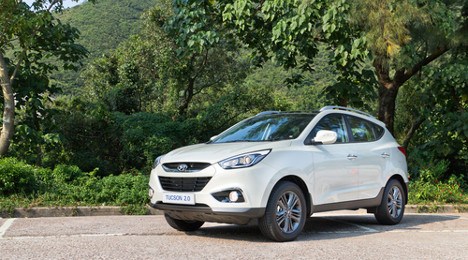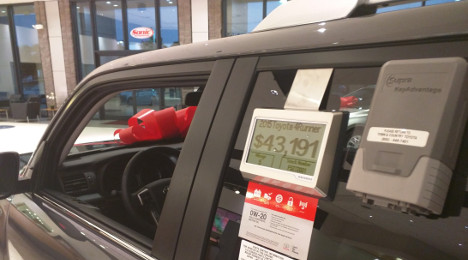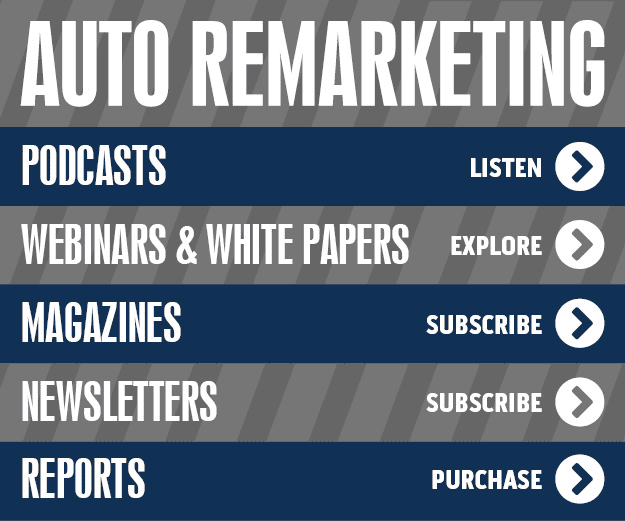Autotrader will be hosting its final Interactive Dealer Summit of 2015 at the beginning of December in Atlanta – if you cannot make it, a free simulcast will be available.
The event will be streaming from Atlanta on Tuesday, Dec. 15 from 9 a.m. to 3:30 p.m. EST. Register here.
What can you expect to learn about? Autotrader will be discussing the latest information from industry thought leaders on car-shopping behaviors and how it interacts with real life and the Internet world.
Autotrader’s Interactive Dealer Summits regularly include speakers from Autotrader, Cox Automotive, Haystak Digital Marketing, Kelley Blue Book, vAuto and VinSolutions.
A link to view the simulcast of the event will be provided following registration.
According to Autotrader, the Interactive Dealer Summit speakers will be discussing the following topics:
- How today's customers shop for cars
- How to improve dealer visibility in the digital marketplace
- How to reach today's consumer at every stage of their car-shopping journey
- How to build in-store processes that produce great sales results
Ally Financial, in partnership with local dealer Classic Chevrolet of Grapevine, Texas, recently presented over $180,000 in donations to ten charities in the Dallas area.
The donations culminated from an auction hosted by Ally’s SmartAuction platform, which celebrated its 5 millionth vehicle sale. That 5 millionth vehicle was auctioned off with the promise that the proceeds would be donated to the auction winner’s selected charities.
As you probably guessed, Classic Chevrolet won that bid and selected ten local charities to receive the donations.
"It's great to be able to celebrate such an important milestone by giving back to a dealer that uses SmartAuction to buy and sell vehicles," said Steve Kapusta, vice president of dealership online services and remarketing at Ally. "Tom Durant of Classic Chevrolet is an outstanding member of the community, supporting many local charitable organizations, so it is our honor to support his efforts with these grants."
The organizations that received the grants included: 6 Stones Mission Network, Christ's Haven for Children, The Angel Fund of Trinity High School, RISE Adventures, Grapevine Relief and Community Exchange, Food for the Soul, VAST (Valuable After School Time), Christian Community Storehouse of Kelleher, North Texas SNAP and Neuro Fitness.
"Ally's SmartAuction platform is an important tool for us when buying and selling inventory, so it was great to take part in the charity auction," said Tom Durant, owner of Classic Chevrolet. "We are incredibly proud that the funds from this auction will help many organizations in our community that make a difference in so many lives."
Thirty-three percent – that’s the increase in lease maturities expected to possibly return to market in 2016 compared to this year – which translates to roughly 800,000 additional units on a year-over-year basis.
That’s according to J.D. Power’s estimates provided by Larry Dixon, the senior manager of market intelligence at NADA Used Car Guide.
Perhaps the most interesting angle of these anticipated lease returns, as mentioned in Auto Remarketing’s recent analysis of used-vehicle supply increases, is that the majority of vehicles expected to come back in 2016 don’t exactly fall in line with what’s selling right now.
According to Dixon, the off-lease supply in 2016 will be split as follows:
- 56 percent cars
- 44 percent trucks
But if you look at the broad-segment breakdown of current year-to-date new-vehicle sales, you’ll see that the opposite is the current trend in shopping interests:
- 56 percent trucks
- 44 percent cars
Let’s dive a bit deeper into those figures.
Compact and midsize cars, in terms of those two segments’ total share of lease maturities for 2016 to 2017, will average 33 percent. As Dixon points out, these two segments have experienced particularly soft pricing in both the new- and used-vehicle markets.
J.D. Power’s current year-to-date figures for those two segments, for used vehicles up to eight years in age, reveals a depreciation rate of 14.6 percent, compared to the overall market depreciation of 11.7 percent.
And Dixon says dealers can expect additional softness in used-vehicle prices next year as these off-lease vehicles return to market and inflate supply.
As expected, the vehicles returning next year will be predominantly three years of age, falling in line with what is typically the most-popular lease term.
Data from J.D. Power’s Power Information Network (PIN) reveals that lease terms between 36 and 41.9 months made up 79.4 percent of the lease originations made in 2013. That share stands at 80 percent CYTD.
Consolidated Asset Recovery Systems’ fourth appearance on the Triangle Business Journal’s annual Fast 50 list is also its first time coming in at No. 1, representing the top of the top of the fastest-growing private companies in the Raleigh-Durham area.
The company was founded by two software supply chain experts, Steven Norwood and Terry Groves, in 2005.
“We have a long history of growth and profitability,” Norwood said. “Our financial stability in the industry makes us the partner of choice for many service providers such as repossession, skip trace, door knock and auction agents. We are extremely grateful to our employees, customers and partners for helping make us the number one company on this year’s TBJ Fast 50 list.”
The Triangle Business Journal selects and ranks its Fast 50 winners annually based on a formula that counts revenue growth and profitability in the preceding three years – in this case, 2012 through 2014. The results and rankings were analyzed and verified by PwC, an accounting firm.
To find out more about CARS, visit its site here.
The analysts at Edmunds.com set out explore an interesting question. Since there are a variety of vehicles named after geographical locations – examples being the Toyota Tacoma, Hyundai Tucson, Chevrolet Colorado, etc. – are any of these vehicles actually popular in the areas they’re named after?
Picking through Polk’s registration data – the answer to that is pretty clear: No, the vehicles are not particularly popular in the areas they’re named after. So, if they were, what should they be named?
Check out the following analysis from Edmunds:
Vehicle name: Buick LaCrosse
New name: Buick Kincaid
Only 0.2 percent of new cars purchased this year in La Crosse, Wisc. were a Buick LaCrosse. In fact, 4,752 other cities and towns in the U.S. enjoyed a larger share of LaCrosses. But if you want to find the biggest concentration of Buick LaCrosse sales, follow the Mississippi River about 400 miles south toward Kincaid, Ill., where the sedan made up 8.9 percent of all new-car registrations this year. With an area under one square mile and a population of less than 1,500 people, Kincaid can nevertheless claim the title of the "LaCrosse Capital of the United States."
Vehicle name: Chevrolet Colorado
New name: Chevrolet Montana
You'd expect this versatile truck to be a top choice for Coloradoans to navigate the rugged Rocky Mountain terrain, right? Wrong. Colorado is actually the 34th most popular state for the compact pickup, which makes up just 0.5 percent of the state's new vehicle registrations so far in 2015. So where are you most likely to find the Chevy Colorado? Head two states north to Montana, where the truck has made up two percent of all new vehicle purchases this year. And let's be honest: "Chevy Montana" sounds like the kind of truck you'd want to help you herd livestock through the Great Plains.
Vehicle name: Chevrolet Malibu
New name: Chevrolet Garciasville
As it turns out, there isn't a whole lot of Southern California love for the Chevy Malibu. Only 0.1 percent of new car registrations in its namesake community carried the Malibu nameplate this year, ranking the beachside city as the 10,789th most popular locale for the vehicle. If you want to find the top town, you'll have to travel 1,600 miles away from Malibu to Garciasville, Texas, located just over the Mexican border on the Rio Grande, where more than 15 percent of all new car registrations this year are Chevy Malibus.
Vehicle name: Dodge Durango
New name: Dodge Castle Dale
On the surface, "Durango" is a perfect name for this vehicle. It suggests a certain toughness that you'd want in your SUV. Too bad for Dodge that the folks in Durango, Colo. aren't responding accordingly. Only 0.5 percent of car buyers in this picturesque mountain town opted for the Dodge SUV. But one place where this vehicle is most appreciated is less than one gas tank away in Castle Dale, Utah, where 7.7 percent of all new car purchases this year were Durangos.
Vehicle name: Hyundai Santa Fe
New name: Hyundai Clements
Santa Fe might be the capital of New Mexico, but it's far from being the capital of its eponymous SUV. Only one tenth of one percent of all new car purchases in this city of about 70,000 people were Hyundai Santa Fes year to date. One place where the Santa Fe SUV is truly appreciated, though, is Clements, Md. So far in 2015, 5.6 percent of all new car sales in this unincorporated town in the heart of the Chesapeake region were Santa Fes.
Vehicle name: Hyundai Tucson
New name: Hyundai Wilmington or Hyundai Fort Garland
The folks in Tucson may be able to rally around their Arizona Wildcats, but there's far less enthusiasm for the car that shares the city's name. Only four tenths of one percent of all new cars registered there this year were Hyundai Tucsons. But there is a spirited battle underway to claim this compact SUV: both Wilmington, N.Y. and Fort Garland, Colo. boast the largest share of Tucsons (6.7 percent of all new sales). In one corner you have Wilmington, which is perhaps most famous for hosting the alpine skiing events during the 1980 Winter Olympics. In the other corner, there's Fort Garland, where the average snowfall is 47 inches per year. Maybe these towns should settle this Tucson battle with a good old-fashioned snowball fight!
Vehicle name: Kia Sedona
New name: Kia Cedar Grove
Where's the "Sedona Spirit" in Sedona, Ariz.?! Not a single new Kia Sedona has been registered in its namesake town this year. Maybe Kia should start market research into the "Kia Cedar Grove." After all, nearly 13 percent of all new car purchases registered in this sleepy West Virginia town were Kia Sedonas. Perhaps the vehicle is more suited to navigate the Appalachian Mountains than the dusty desert terrain?
Vehicle name: Toyota Tacoma
New name: Toyota Kilauea
Almost two percent of vehicles registered this year in Tacoma, WA were Toyota Tacomas, which is relatively impressive, except when you consider that 5,492 other U.S. cities and towns have a better showing. Unfortunately, it's impossible to drive a Tacoma from Washington state to the place where the compact truck is most popular. That's because the town with the highest rate of Toyota Tacoma purchases this year is 2,600 miles of ocean away in Kilauea, Hawaii. Believe it or not, more than one out of every four new cars registered this year in this Hawaiian paradise (26.5 percent, to be exact) is a Toyota Tacoma. That sort of brand loyalty is enough to make any Toyota executive say "Aloha!"
It’s that time of year again – the time of “Movember” and “No-Shave November.”
As we’re a couple of weeks into the month of November, you may be noticing quite a few men sporting freshly grown facial hair of various shapes, sizes and intensities, many in the name of various men’s health awareness initiatives.
One notable organization – the Movember Foundation – uses this time especially to collect donations to fight various men’s health issues, including prostate cancer, testicular cancer, poor mental health and physical inactivity.
And Autotrader would like to help.
On its own Movember website, Autotrader is sponsoring a campaign to assist the Movember Foundation by gathering mustached selfies from its dealer and OEM clients and donating $1 to the foundation for every selfie posted (up to a total donation of $2,000). Autotrader also says it will donate $3,000 on behalf of the client team that raises the most money. Teams can register here.
"Community service and wellness are core company values Autotrader shares with our dealer and OEM clients,” said Kevin Filan, vice president of customer marketing at Cox Automotive, Autotrader’s parent company. “We are very happy to lend our support to the important work related to men’s health that is being undertaken by the Movember Foundation.”
Dealers that fail to invest in consumer-facing technologies risk being trumped by competitors.
That’s the message from J.D. Power following its 2015 U.S. Sales Satisfaction Index Study released on Thursday.
J.D. Power’s study, in its 29th year, measures customer satisfaction with the sales experience for new-vehicle shoppers — for both buyers and non-buyers — to gauge what works and what does not to keep customers satisfied.
This year, the company highlighted especially the importance of utilizing consumer-facing technologies during the car-shopping process. One example, in particular, pointed out the use of tablets.
According to J.D. Power’s study, among both premium and non-premium buyers, the use of tablets by sales personnel to perform tasks such as recording customer vehicle needs, demonstrating a vehicle’s features and displaying pricing information yielded higher customer satisfaction.
Perhaps most notably in respect to tablets, the study shows that handwritten price quotes had a negative impact on buyer satisfaction.
The study also found that F&I products, such as extended warranties, pre-paid maintenance contracts and tire/road hazard protection helped increase satisfaction to the customers that were presented with the option.
“With retail vehicle sales in the United States in 2015 forecast to reach 14.2 million units and this positive momentum expected to carry into 2016, dealers face challenges in properly servicing a high volume of new-vehicle buyers who are increasingly tech savvy,” said Chris Sutton, vice president of the automotive retail practice at J.D. Power. “Dealerships should understand that customers want and trust technology and that it can enhance efficiencies. Dealers that disregard it may risk being left behind in three to five years. Customers are experiencing interesting uses of technology in many of their other retail transactions — and now expect this in auto.”
Here are some other key findings of the study, listed by J.D. Power:
- Sales staff remain vital to sales experience: The most impactful sales satisfaction key performance indicator (KPI)—best practice—is interacting with a salesperson who understands the customer’s needs completely (+106 points). Such salespersons are good listeners, ask relevant questions and are able to deliver on customer requests. This KPI demonstrates that even with the growing prevalence of online communications and emphasis on an efficient transaction, the salesperson still plays a key role.
- 5 of top-10 KPIs relate to working out the deal: Among the most impactful KPIs are five that involve making customers feel comfortable (not pressured) and confident they are receiving the most transparent and up-front information to aid their decision-making while at the dealership. Delivering on these best practices improves satisfaction and builds loyalty and advocacy.
- Gen Y equally interested in safety and protecting vehicle value as other generations: Among generational groups, Gen Y is as likely to purchase F&I products as other generations. For example, by generation, the following proportions of customers purchase tire/road hazard protection: Gen Y (21 percent); Gen X (21 percent); Boomer (20 percent); and Pre-Boomer (20 percent).
Among brands, Porsche ranked the highest on a 1,000-point scale in customer satisfaction with a score of 752, marking a 14-point increase over last year. MINI, for the sixth-year straight, ranked highest among the mass-market brands, with a score of 762 (35 points over last year).
Want to check out the full study? Click here.
Dealers: ever wish the hang tags for your inventory on the lot would update themselves? That’s the aim for eCarTag, a subsidiary of Pearl Technology Holdings, who announced that its digital hang tags have just completed a first test pilot with Sonic Automotive, who plans to install the tags at all of its dealerships next year.
Sonic tested the tags for 90 days at its flagship dealership, Town and Country Toyota, in Charlotte, N.C.
Following what Pearl says was an “overwhelmingly successful” pilot, the company says that Sonic has ordered tags for its entire new and pre-owned inventory across the country, with a rollout to begin in 2016.
“We were thrilled that the pilot was so successful,” said Jeff Dyke, Sonic Automotive’s executive vice president of operations. “Dealers can sympathize with the amount of labor and effort that goes into changing paper tags on a daily basis in more than 100 Sonic dealerships across the U.S.
“Here at Sonic we have aggressive market pricing strategies across our dealerships that utilize a central custom pricing platform. The tags solve a huge issue for us and give us the speed and technology we have desperately needed. Such a simple idea, but not so simple to execute. So, I commend Pearl for bringing eCarTag to market and I’m sure other dealers will do the same.”
According to Pearl, the eCarTag digital tags are battery powered with an estimated battery life of approximately four years and a replacement cost of said batteries of only a “few dollars.” The tags can be installed and programmed by simply scanning a vehicle’s VIN and the digital tag with a smartphone. The tag then instantly synchronizes the vehicle to its listed price, which will proceed to update automatically.
The tags have other tricks, too, such as displaying up to five different messages in rotation, which can display targeted messages such as lowest payments, promoted sales, or even congratulate a customer who just purchased the vehicle.
“Paper hang tags have long been a hassle for dealers and are one of the most glaring changes that have been needed for decades,” said Bruce Thompson, Pearl’s chief executive officer. “Dealers are changing prices on the Internet faster than ever before. They pay attention to the competition and some dealers change prices daily. Most states regulate that the price on the Internet and the price on the lot must be the same.
“This creates a huge logistical challenge at the dealership. We simply catch the Internet feed from the dealer’s listing tool and as prices change on the Internet, they are instantly changed on the lot.”
For more information on eCarTags, visit its site here.
The DARCARS Automotive Group announced Monday that it has added Honda of Bowie to its list of franchises, bringing the overall tally to 38 franchises in more than 20 locations.
Labeling itself as the largest group of car dealerships in the greater Washington, D.C., metropolitan area, DARCARS also said that the Honda dealership will immediately be renamed DARCARS Honda.
"We are making an important investment in DARCARS' future and furthering our mission to create the best place to work," said John Darvish, DARCARS’ president and chief executive officer. "Throughout our discussions with Honda of Bowie ownership, I have been extremely impressed with their innovative management, highly-motivated team and very profitable business. We look forward to welcoming Honda of Bowie employees and customers to the DARCARS family."
Phil Morelli, the president of Honda of Bowie, commented on why it made sense to join the DARCARS team.
"DARCARS brings expanded resources to the table that will enable Honda of Bowie to rise to new levels in sales and customer service," Morelli said. "The existing culture and business model at Honda of Bowie align well with those of DARCARS and we know that our team will be in good hands as they join the DARCARS team."
For more information on the DARCARS Automotive Group, visit it site here.
In the last seven years, the average age of vehicles on the road in the U.S. increased by 15 percent to 11.5 years.
How will that rate change in the next five years? According to Mark Seng, the global aftermarket practice leader for IHS Automotive, the company’s prediction is an increase in overall average age of about 3 percent by 2020.
While that may not sound like a lot, where dealers can make strategic moves to position themselves for maximum potential profit is to look at which segments will see the biggest growth.
According to IHS, by the year 2020, the segment of vehicles aged zero to 5 years will see the biggest growth – a predicted jump of 24 percent. The volume of vehicles over 12-years-old is expected to increase by 15 percent, while the 6- to 11-year-old segment is anticipated to see a decrease of 11 percent.
If you’re not catching on already, why is this good for you? For one, those older cars will need to be worked on. Therein lies an opportunity for service of all kinds. IHS predicts that the vehicles in operation that are 16-years-old or older will number at approximately 76 million — quite the jump if you consider there were just 35 million vehicles in that age range in 2002.
Talking at the Automotive Aftermarket Products Expo in Las Vegas on Wednesday, Seng says the most successful companies will be those that take advantage of the age shift.
“The aftermarket may need to begin thinking differently about the repair ‘sweet spot’ as vehicles age and consumer behaviors change. Success will require that businesses adapt to the evolution in a timely manner,” Seng said. “Nimble aftermarket organizations that embrace and prepare for the changes underway will have the greatest opportunity to succeed moving forward.”
Segment shifts more toward imports and crossovers?
Looking at U.S. light vehicle sales, IHS points out the dominance sales of compact CUVs, traditional mid-size sedans, traditional compacts and full-size pickups, which, together, made up over 58 percent of new-vehicle registrations made last year. The company anticipates that the CUV phenomenon will continue in the near term while compact and mid-size sedans will continue to maintain popularity.
Import vehicles currently represent a 27.3 percent share of vehicles in operation in the U.S. IHS expects that percentage may jump to 47 percent by 2020. Imported light trucks have seen a 10 percent jump in share since 2007, now currently representing 15.7 percent of the VIO in the U.S.
Also since 2007, the share of domestic cars has decreased by 2 percent, to 37.4 percent of vehicles in operation, while domestic light trucks represent 19.6 percent, down nearly 8 percent since 2007.
IHS also estimates that nearly 60 percent of light vehicle production will be built on global platforms, giving companies another opportunities to know what to expect and prepare in terms of parts and service.












